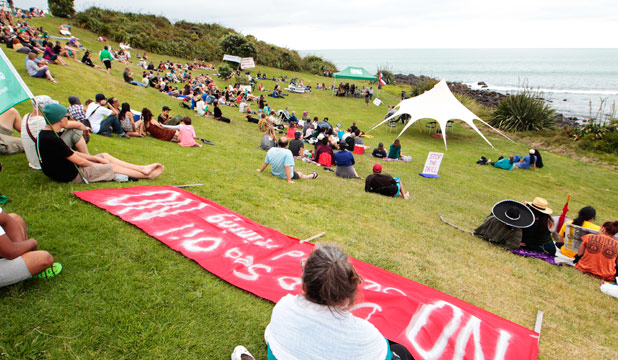http://www.ogfj.com/articles/2014/01/epa-issues-npdes-permit-that-includes-limited-chemical-disclosure-requirements-for-oil-and-gas-operations-offshore-california.html
January 22, 2014
Michael Weller and Jason Hutt
Bracewell & Giuliani LLP
Region 9 of the US Environmental Protection Agency recently made available the finalized National Pollutant Discharge Elimination System (NPDES) general permit applicable to discharges from oil and gas exploration facilities offshore Southern California. NPDES General Permit No. CAG280000 (2014 NPDES General Permit), issued under provisions of the Clean Water Act, authorizes discharges from exploration, development and production facilities located offshore of Southern California in accordance with specified effluent limitations, monitoring and reporting requirements and various other conditions.
The final 2014 NPDES General Permit includes certain new requirements that EPA indicates were added to address offshore hydraulic fracturing operations, including increases in the monitoring requirements associated with produced water discharges and new inventory and reporting requirements.
While operating offshore, waste streams generated by oil and gas operations are generally either treated and discharged via a NPDES permit or shipped back to shore for disposal. The 2014 NPDES General Permit authorizes discharges from 23 platforms operating offshore Southern California, including discharges of Drilling Fluids and Cuttings, Produced Water, Well Treatment, Completion and Workover Fluids, Bilge Water, and Water Flooding Discharges.
This reissuance of the 2004 NPDES general permit was initially proposed in 2012. During the public comment period, the U.S. Department of Interior, Bureau of Safety and Environmental Enforcement (BSEE), several California legislators and the California Coastal Commission (CCC) expressed interest in hydraulic fracturing operations offshore of California. To address the concerns raised over offshore hydraulic fracturing, EPA changed portions of the final general permit, adding new testing and reporting requirements.
Background
Section 301(a) of the Clean Water Act prohibits point source discharges of pollutants into navigable waters unless in compliance with a permit. To comply with the prohibition on point source discharges, businesses typically obtain CWA Section 402 permits from the state; however, because these operations are offshore, EPA issues the NPDES permits directly. Under the NPDES program, EPA may issue individual permits or general permits. The latter allows the Agency to authorize discharges from a large number of facilities engaged in the same activity. When EPA issues a general permit, a prospective permittee simply submits an application for coverage and then abides by the terms and conditions of the general permit.
Monitoring requirements
NDPES general permits typically contain monitoring requirements. In its response to public comments on the 2014 NDPES General Permit, EPA indicated that it has increased the mandatory Whole Effluent Toxicity or “WET” testing for produced water discharges from an annual to a quarterly requirement. EPA indicated that, because the chemicals used in hydraulic fracturing operations are “commonly commingled and discharged with produced water,” the mandatory tests applicable to produced water will address any concerns over discharges associated with hydraulic fracturing operations.
Inventory/reporting requirements
NPDES permits may also contain inventory and reporting requirements. In the 2004 version of this particular NPDES permit, EPA required that permittees maintain inventories and report drilling fluid constituents added downhole for all discharges of “Drilling Fluids and Cuttings.” In the 2004 version, the mandatory inventory and reporting requirement only applied to mud systems and there was no such requirement for “Well Treatment, Completion and Workover Fluids.”
The 2014 NDPES General Permit includes that same requirement for discharges of “Drilling Fluids and Cuttings.” However, the permittee must also now submit detailed information for discharges of “Well Treatment, Completion and Workover Fluids,” which includes chemicals used in hydraulic fracturing. Specifically, EPA added Part II.C.3 to the 2014 NPDES General Permit, which requires the permittee to:
1. maintain an inventory of the quantities and application rates of chemicals used to formulate well treatment, completion and workover fluids; and
2. if those fluids are discharged, report to EPA Region 9 the chemical formulation of the discharges and the discharge volume with the operators quarterly discharge monitoring reports.
The disclosures under the 2014 NDPES General Permit are not to the “public” and EPA has indicated that the inventory would be available to EPA where the Agency “deems it necessary to meet the purposes of the CWA. For example, in case of well failure or other accident resulting in an unexpected discharge, EPA may access such inventory in order to immediately assess emergency response needs.” It is not yet clear how the chemical formulations must be reported or to what extent trade secret protections are available.
The public comment period for the 2014 NPDES General Permit closed nearly one year ago on February 4, 2013. The effective date of the permit is March 1, 2014.
Michael Weller is member of the firm’s environmental and natural resources practice in Washington DC.
Jason Hutt is a partner in the firm’s Washington, DC office. He counsels clients on current and upcoming regulatory developments at the nexus of environmental and energy policy, with focused attention on natural gas development, including hydraulic fracturing.
Special thanks to Richard Charter
